November 2017 saw winter arrive in the Cairngorms National park, with temperatures consistently below the monthly average, and snow down to lower levels from mid-month. Though the weather overall was a bit changeable, we had enough decent days to allow us to get out and enjoy the last of the autumn colours, some spectacular snowy scenery and many memorable wildlife sightings.
Though the days are shortening noticeably now, with only around 8-9 hours of usable daylight, a further influx of winter-visiting birds from further north, including a few rarities, helped to boost local full-day bird day-lists into the low 40's, or more if you include a trip to the nearby Moray Coast, whilst mammal day-lists varied between 3 and 7 species, depending on the time of our start, and variety of habitats visited.
 |
| When the going gets tough.. thank goodness for 4-wheel drive... and heated seats.... |
To give you an idea of what you may realistically hope to see if you are planning a future November visit, I hope the following more detailed information, illustrated with photos taken at sites in and around the Cairngorms National Park by myself, my friends or my safari clients, will help....clicking on the picture enlarges it to full-screen.
Wildlife highlights included:
Local speciality/upland bird species seen regularly during the month included:
Crested Tit, Black Grouse (at dawn only), Red Grouse, Dipper, Golden Eagle, and White-Tailed Eagle, and we also had a few sightings of Snow Bunting at lower levels late in the month. and one brief view of Merlin, but sadly, Crossbills were frustratingly elusive again. A good variety of waders and wildfowl were seen at the Moray Coast, and winter visiting birds were represented by Whooper Swans, several species of 'grey' Geese, Redwings and Fieldfares, whilst a couple of small and annoyingly mobile flocks of Waxwings were seen feeding on berries occasionally during the month...the first Bramblings of this winter were seen on local farmland, and a Bittern was reported at a local loch....
Mammal species seen regularly included: Red Squirrel, Red Deer, Reindeer, Roe Deer, Mountain Goat , and Rabbit......with just a few views of Brown Hare, Mountain Hare and Bank Vole, and a couple of brief glimpse of Stoat.....The first half of the month also saw us continue to enjoy great views of Atlantic Salmon spawning in the upper reaches of our local rivers....
Winter is actually the best time to see Crested Tits, as the weather turns colder and snowier, with the easy pickings on offer at my forest feeding stations, especially soon after dawn, seemingly proving to be almost irresistible. It was a great feeling to show off these true 'Speyside specialities' to my safari clients, especially those who were seeing them for the very first time.
Still in the Caledonian pine forests, Crossbills continued to be a bit of a 'bogey-bird', with (yet again) sightings mainly restricted to snatched glimpses of calling birds flying around the tree tops...
 |
| Black Grouse |
Black Grouse are always popular with my safari clients, probably because of their relative rarity and sadly, declining numbers over much of the UK, However, we are fortunate to have good numbers in Highland Scotland, and our dawn visits to their traditional local moorland 'lek' sites were usually fruitful, with a maximum of 6, and an average of 4 cock birds seen showing and sometimes even displaying well this month, with cold, still, frosty mornings generally proving more successful than wet and windy ones.
 |
| Red Grouse |
Red Grouse too, being birds of very specific upland heather moorland habitat, are absent from much of the UK these days as well. Thankfully though, we have no shortage of them in this area, and it was interesting to note that once the snow arrived, they seemed to group up into 'super-flocks' often containing dozens of birds, rather than the more usual family sized parties.
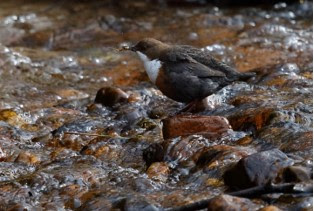 |
| Dipper by Nigel Wedge |
On the rivers, our local Dippers are definitely becoming more aggressive now, with much displaying, dawn singing and chasing each other around being witnessed as they presumably seek to establish winter and breeding territories, and it still makes me shiver every time I see them disappear under the icy water in search of food - they sure are tough little critters!
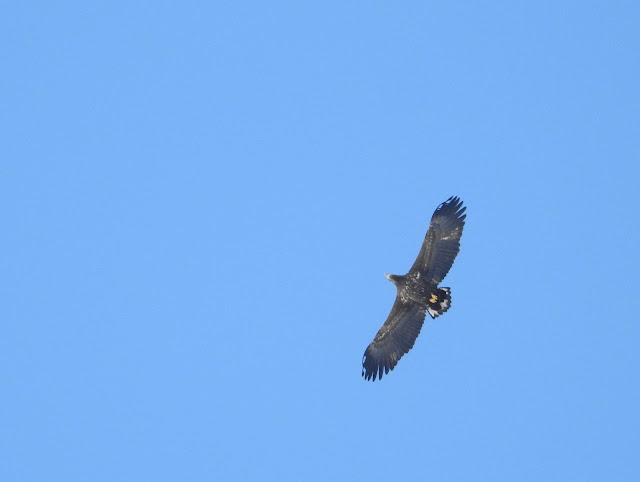 |
| White-Tailed Eagle |
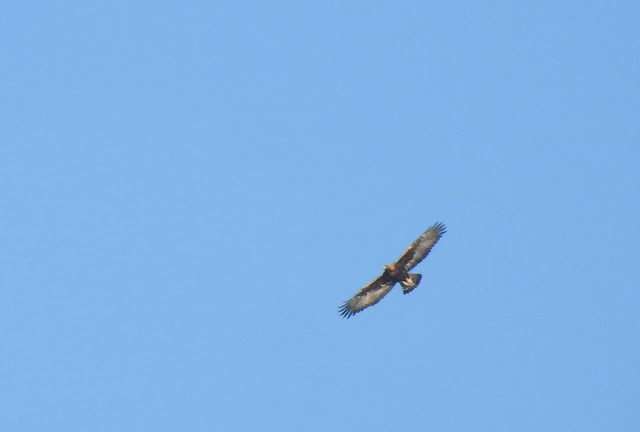 |
| Golden Eagle |
As I have mentioned in previous years, and with no apologies for repeating myself... November is in my opinion, THE month for raptor sightings in this area, and so it proved again this year, with my favourite local upland glens and moors providing my safari clients and I with pleasingly regular sightings, and even the odd (very rare) photo opportunity, of the much coveted Golden Eagle and White -Tailed Eagle, with these awesome and majestic 'Kings of the skies' providing great entertainment, numerous 'life-ticks' and putting big smiles on many faces....
The regular 'raptor back-up cast' of Kestrel, Sparrowhawk, Peregrine, Buzzard , Red Kite, and even the occasional Merlin, Hen Harrier and Goshawk, should not be forgotten though....
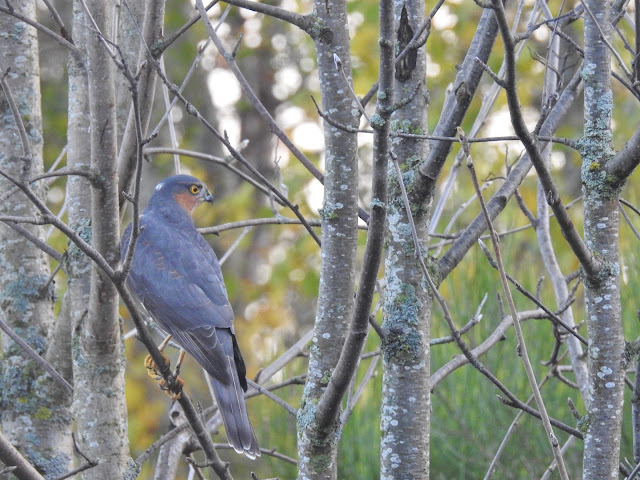 |
| Sparrowhawk |
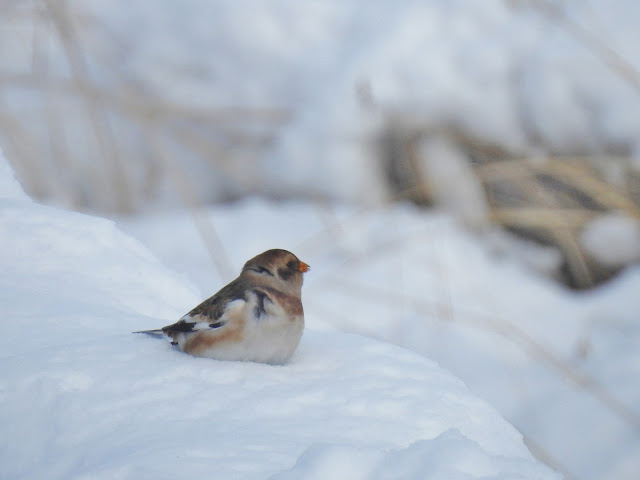 |
| Snow Bunting |
Snow Buntings became a lot easier to see than normal, as they began to frequent known lower altitude sites, possibly driven down from the mountain tops by the snow and cold, and with their numbers likely to have been swelled by visitors from Scandinavia...and I am always sure to have a bag of wild bird seed on board, as they can often be tempted to come and feed at quite close range....
 |
| Ptarmigan (pic taken by myself in Nov 2014) |
Although I didn't venture up into the mountain-tops myself this month, I understand that with a bit of effort, a few Ptarmigan , now almost totally white, could be seen, usually sheltering on the leeward sides of ridges, out of the cold wind...
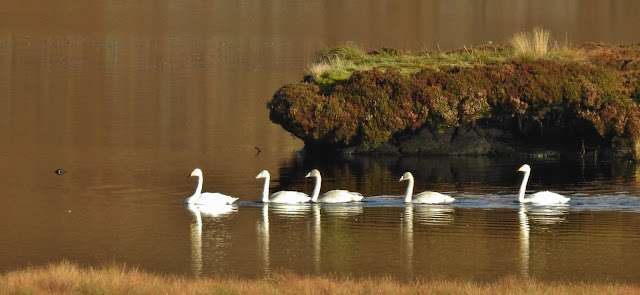 |
| Whooper Swans |
The Moray coast is only about an hours drive north East of Aviemore, and a couple of trips to favourite reserves, lochs, bays and harbours gave good views of winter visitors such as Greylag Geese, Barnacle Geese, Pink-Footed Geese, Brent Geese,Whooper Swan, Wigeon, Teal, Scaup, Pochard, Pintail, Bar-Tailed Godwit, Knot, Golden Plover ,Grey Plover, Purple Sandpiper , a few Little Auks, and even a King Eider and an American Wigeon were reported....
Other good birds reported locally this month included: Redpoll, Kingfisher, Great Grey Shrike and Jack snipe....
Onto mammals now....
 |
| Red Squirrel |
Red Squirrel moved back to the top of the 'Mammal of the day' charts this month, and who am I to disagree?
Being rare, attractive, charismatic and cute, they certainly tick a lot of boxes, and thankfully, they can usually be relied upon to put in an appearance at forest feeding stations in the winter months....
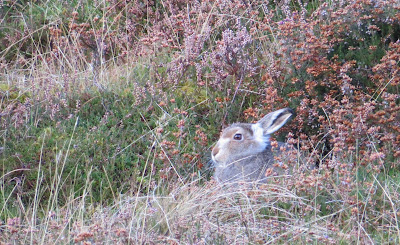 |
| Mountain Hare |
Mountain Hares , now they are turning 'winter white' also often feature on my safari clients wish-lists at this time of year, and we were fortunate enough to see them in their snowy upland habitats on a number of occasions, though not as frequently as in previous years.....please be aware though, that a bit of rough uphill walking is likely to be required for photography purposes..
 |
| Red Deer |
Although the autumn 'rut' is now over and seemingly already forgotten by the participants!, it was still a treat to see the magnificent fully antlered Red Deer stags in their favoured upland glens, occasionally above the snow-line, with close-up views often leaving my safari clients surprised at their impressive size and powerful build....
 |
| Roe Deer |
Roe Deer, whilst not quite as impressive as the Reds, are still nice to see, though they can be a little crepuscular, rarely showing well outside of the low-light times of dawn and dusk, and they are generally pretty wary of human disturbance.....so you need to be quick with your camera!
Our local feral Mountain Goats proved to be unusually elusive this month, with our sightings mainly reduced to long-distance views through the scope....and sadly, no decent photo opportunities......
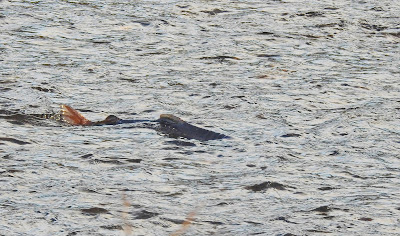 |
| Spawning Atlantic Salmon |
November is usually the best month of the year to see our Atlantic Salmon spawning. These remarkable and often very large fish spawn in the shallow waters in the upper reaches of our rivers, at the very spot where they themselves were hatched several years before, having originally spent 2-3 years in the river, then another 2-3 years feeding, growing and maturing out in the mid Atlantic, before undertaking a perilous journey many miles upriver, often involving avoiding poachers and predators and negotiating high falls and rapids on the way - an amazing migration story! However, sightings are very reliant on the rivers water levels - too little water and the Salmon cannot access the upper reaches - too much water, and they can get there... but we can't see them. As I mentioned last month though, this autumn we got lucky with everything falling into place, and good sightings being enjoyed up until the third week of this month..
 |
| Abernethy Forest |
So, although many people that I know seem to get the 'winter-blues' as the days shorten and the temperatures drop , as a keen wildlife watcher and photographer, it is far from the case for me up here, with November now one of my favourite and, weather permitting of course, often most productive safari months, with lots of great wildlife to be enjoyed, some of our 'local speciality species' at their easiest to see, and all in spectacular and often snowy scenery.....
If you think you know someone who may enjoy a taste of what I do, why not treat them to a safari gift certificate. They make a thoughtful and imaginative present and are available for any amount in multiples of £10, and are valid at any time within a year from date of purchase....
 |
| Late autumn at Insh marshes |










